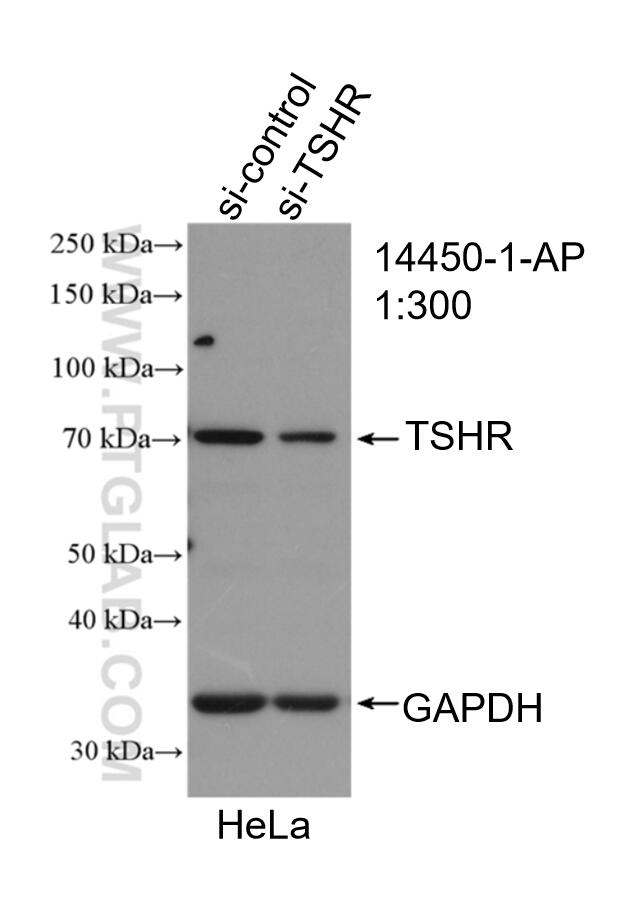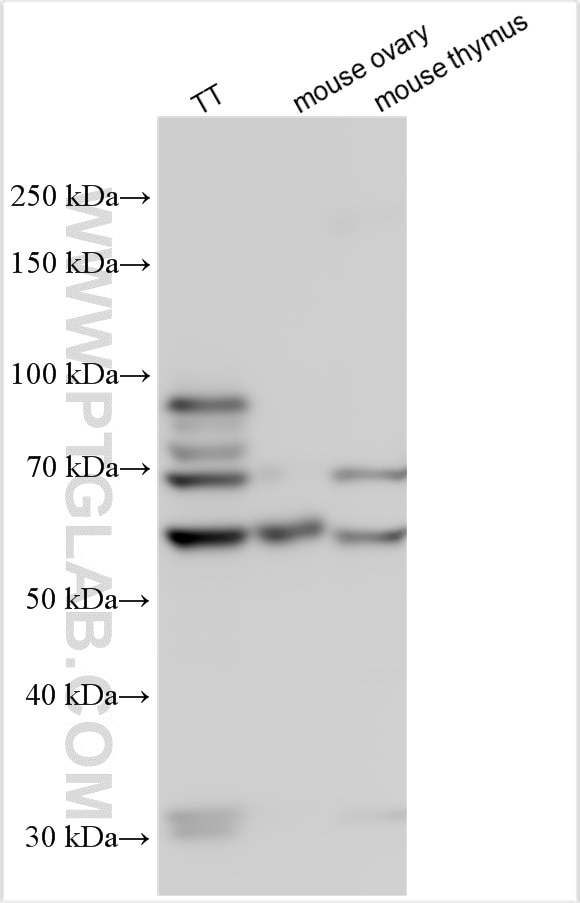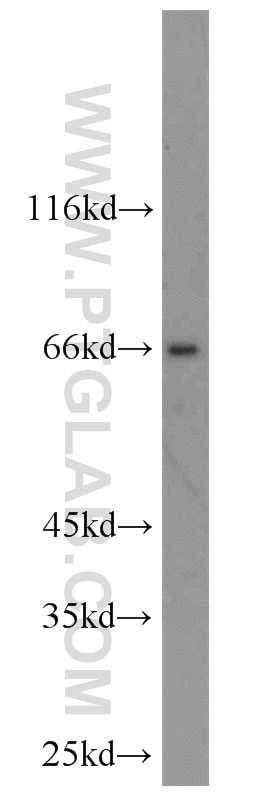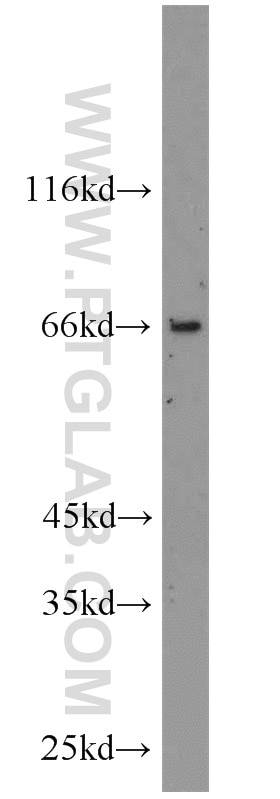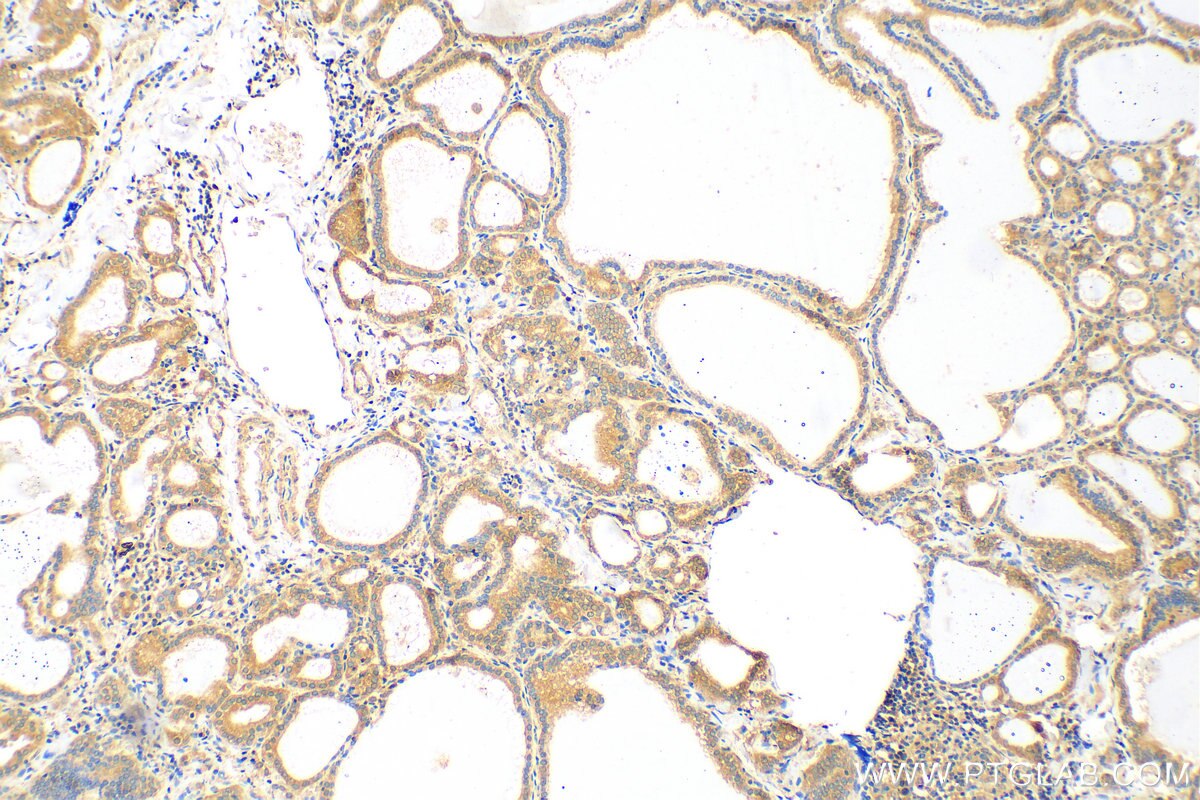- Featured Product
- KD/KO Validated
TSHR Polyklonaler Antikörper
TSHR Polyklonal Antikörper für WB, IHC, ELISA
Wirt / Isotyp
Kaninchen / IgG
Getestete Reaktivität
human, Maus, Ratte und mehr (1)
Anwendung
WB, IHC, IF, ELISA
Konjugation
Unkonjugiert
Kat-Nr. : 14450-1-AP
Synonyme
Geprüfte Anwendungen
| Erfolgreiche Detektion in WB | TT cells, HeLa-Zellen, Maus-Eierstockgewebe, Maus-Thymusgewebe |
| Erfolgreiche Detektion in IHC | humanes Schilddrüsenkarzinomgewebe Hinweis: Antigendemaskierung mit TE-Puffer pH 9,0 empfohlen. (*) Wahlweise kann die Antigendemaskierung auch mit Citratpuffer pH 6,0 erfolgen. |
Empfohlene Verdünnung
| Anwendung | Verdünnung |
|---|---|
| Western Blot (WB) | WB : 1:500-1:1000 |
| Immunhistochemie (IHC) | IHC : 1:50-1:500 |
| It is recommended that this reagent should be titrated in each testing system to obtain optimal results. | |
| Sample-dependent, check data in validation data gallery | |
Veröffentlichte Anwendungen
| WB | See 12 publications below |
| IHC | See 2 publications below |
| IF | See 6 publications below |
Produktinformation
14450-1-AP bindet in WB, IHC, IF, ELISA TSHR und zeigt Reaktivität mit human, Maus, Ratten
| Getestete Reaktivität | human, Maus, Ratte |
| In Publikationen genannte Reaktivität | human, Maus, Zebrafisch |
| Wirt / Isotyp | Kaninchen / IgG |
| Klonalität | Polyklonal |
| Typ | Antikörper |
| Immunogen | TSHR fusion protein Ag5957 |
| Vollständiger Name | thyroid stimulating hormone receptor |
| Berechnetes Molekulargewicht | 87 kDa |
| Beobachtetes Molekulargewicht | 87kDa, 62-70kDa, 28-30kDa |
| GenBank-Zugangsnummer | BC063613 |
| Gene symbol | TSHR |
| Gene ID (NCBI) | 7253 |
| Konjugation | Unkonjugiert |
| Form | Liquid |
| Reinigungsmethode | Antigen-Affinitätsreinigung |
| Lagerungspuffer | PBS with 0.02% sodium azide and 50% glycerol |
| Lagerungsbedingungen | Bei -20°C lagern. Nach dem Versand ein Jahr lang stabil Aliquotieren ist bei -20oC Lagerung nicht notwendig. 20ul Größen enthalten 0,1% BSA. |
Hintergrundinformationen
Thyroid stimulating hormone (also known as thyrotropin or TSH) is a glycoprotein hormone produced by thyrotrophs in the anterior pituitary gland. The TSH receptor (TSHR), mainly expressed on the thyroid epithelial cells, is a G protein-coupled receptor (GPCR) of the seven-transmembrane domain family and plays a central role in controlling thyroid cell metabolism. The gene of TSHR maps to chromosome 14q31.1, and encodes a 764-amino acid protein with a predicted unmodified molecular weight of 86.8 kDa. The apparent molecular weight of glycosylated form is 95-120 kDa. Studies reveal that TSHR is composed of two subunits, A and B, which are produced by cleavage of single-chain TSHR on the cell surface and subsequently connected by disulfide bonds. This rabbit polyclonal antibody raised against N-terminal region (1-253 aa) of human TSHR can detect glycosylated subunit A with an experimentally determined molecular weight of 62-70 kDa under reducing condition. (PMID: 20578897, 17158770, 12593718)
Protokolle
| PRODUKTSPEZIFISCHE PROTOKOLLE | |
|---|---|
| WB protocol for TSHR antibody 14450-1-AP | Protokoll herunterladen |
| IHC protocol for TSHR antibody 14450-1-AP | Protokoll herunterladenl |
| STANDARD-PROTOKOLLE | |
|---|---|
| Klicken Sie hier, um unsere Standardprotokolle anzuzeigen |
Publikationen
| Species | Application | Title |
|---|---|---|
Theranostics Obatoclax and LY3009120 Efficiently Overcome Vemurafenib Resistance in Differentiated Thyroid Cancer. | ||
Int J Nanomedicine A TSHR-Targeting Aptamer in Monocytes Correlating with Clinical Activity in TAO | ||
Oxid Med Cell Longev TSH Combined with TSHR Aggravates Diabetic Peripheral Neuropathy by Promoting Oxidative Stress and Apoptosis in Schwann Cells. | ||
Environ Pollut Acute exposure of zebrafish embryo (Danio rerio) to flutolanil reveals its developmental mechanism of toxicity via disrupting the thyroid system and metabolism. | ||
Cancers (Basel) Patient-Derived Papillary Thyroid Cancer Organoids for Radioactive Iodine Refractory Screening. | ||
Front Endocrinol (Lausanne) Long Non-coding Antisense RNA TNRC6C-AS1 Is Activated in Papillary Thyroid Cancer and Promotes Cancer Progression by Suppressing TNRC6C Expression. |
